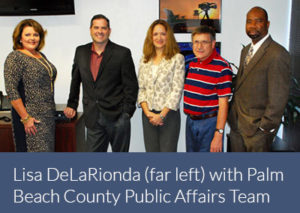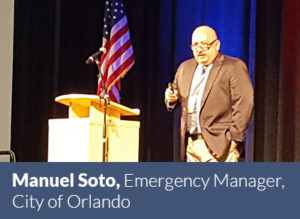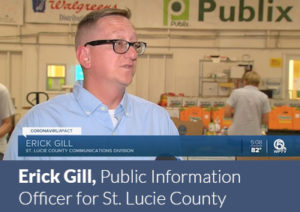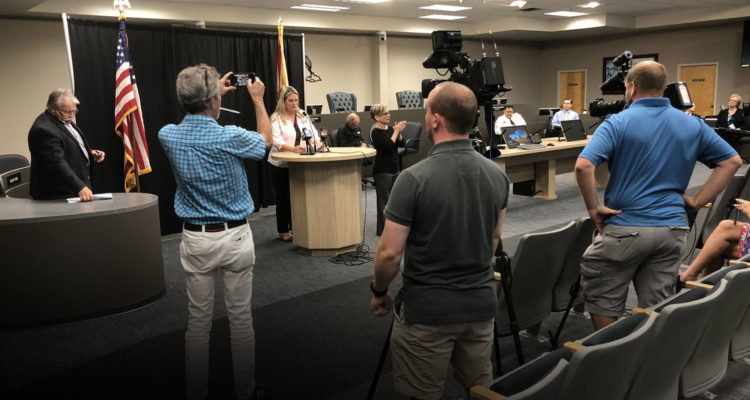Eye of the Storm: Communicating in a Crisis
Communicating Locally During the Global Pandemic
Sunday morning, March 8th – Palm Beach County Public Affairs Director, Lisa DeLaRionda, was working overtime. It was full steam ahead on the Census 2020 campaign and Marilyn Stephens, Assistant Regional Census Manager, just rolled into town. Lisa was responsible for coordinating Stephen’s jam-packed schedule aimed at boosting participation. On the docket was an event with the school district, an event at the Guatemalan-Mayan Center, a women’s luncheon and multiple meetings. Not to mention, Census Invitations were due to drop at Palm Beach County households Monday. Lisa had a lot to think about.
She was making her way through the doors of the County Administration Building when her cellphone rang. It was County Administrator, Verdenia Baker. Lisa picked up. “Where are you? Are you available?” Baker asked.
“Yeah! I’m here downtown,” Lisa said. She assumed it was just another census-related call. It wasn’t.
 The Palm Beach County Public Safety Department gave its first briefing on COVID-19 in early 2020. In late February, Administrator Baker briefed commissioners on the steps the county was taking to gather more information and obtain the necessary personal protective equipment (PPE).
The Palm Beach County Public Safety Department gave its first briefing on COVID-19 in early 2020. In late February, Administrator Baker briefed commissioners on the steps the county was taking to gather more information and obtain the necessary personal protective equipment (PPE).
COVID-19 was certainly on Lisa’s radar, but the virus itself had yet to creep into Palm Beach County. Then Lisa spoke with Baker. She learned a Pennsylvania man attended a conference in West Palm Beach. When he returned home, he tested positive for Coronavirus. In that moment, Lisa went from working overtime on Census 2020 to working in overdrive on what would become the longest, most complicated communications emergency of her career.
Local communications officers like Lisa communicate everyday information the public needs to know. They’re also ready to pivot to crisis communications at a moment’s notice—whether it’s a political issue, natural disaster or tragic event. Nevertheless, local communicators across the board agree: COVID-19 is a different animal altogether.
 “It’s an incredibly fluid, dynamic situation,” said Manuel Soto, Emergency Manager for the City of Orlando. “When we initially started, the information was changing every day, every hour, every minute.”
“It’s an incredibly fluid, dynamic situation,” said Manuel Soto, Emergency Manager for the City of Orlando. “When we initially started, the information was changing every day, every hour, every minute.”
Mathieu Cavell, Assistant to the Leon County Administrator, said local governments are grappling with ever-evolving guidance and information, and have been on call to communicate, day or night, for more than three months now.
“In a hurricane, the immediate recovery phase lasts anywhere from 7 to 10 days,” he said. “Recovery takes months after that but restoring power and clearing roads is the emergent need. In this pandemic, we’ve been activated for over 90 consecutive days.”
 “It’s so odd,” said Erick Gill, Public Information Officer for St. Lucie County. “I remember a reporter asking if the situation felt like a hurricane—it didn’t at all! It was a beautiful spring day in Florida when everything changed.”
“It’s so odd,” said Erick Gill, Public Information Officer for St. Lucie County. “I remember a reporter asking if the situation felt like a hurricane—it didn’t at all! It was a beautiful spring day in Florida when everything changed.”
“We know hurricanes,” said Chrissy Gibson, Communications and Marketing Manager for the City of Boca Raton. “You prepare, you hunker down, we know what recovery looks like. Through this pandemic, my whole team has been working around the clock to provide information in a situation that’s totally new to us. Phased recoveries—what does that look like? We’re all learning together.”
“It’s the perfect example of a crisis that broke all of the rules and changed the world,” said Sandra King, Communications and Marketing Director for the City of Pompano Beach. Sandra has thirty years of public communications experience and has handled various crisis situations from hurricanes, tornadoes and plane crashes to sewage spills. She said one of the most complicated elements has been balancing the multiple City, County, State and Federal orders: “They can be confusing and often contradict each other.”
Chrissy Gibson agreed that maintaining an open line of communication across multiple governments has been essential: “In this pandemic, we’ve been responding to the Governor’s directives, the DOH’s, the CDC’s, the Federal Government’s.”
Erick Gill pointed out that social distancing protocols threw a wrench in the process of coordinating with his own staff, much less other governments: “Normally, I know where everyone is and can walk to that side of the office,” he said. “Now you have to email, text, call, deal with the frustrations of a Zoom meeting. Not to mention, a lot of departments had a laptop, but none with a camera. It was an adjustment at first.”
Mathieu said getting the right information and contending with technical difficulties is tough, but communicating the message everyone needs to hear right now is tougher: “It’s certainly difficult to tell everyone we’re in this together, and then ask everyone to be as separate as possible—but communicating things that are hard to hear is part of the job.”
Through all the tangential clutter, ever-changing information and the sometimes-contradictory guidelines, Erick Gill is hoping residents remember the fact that local government staffers are also family, neighbors and friends: “We share the same concerns, anxieties and frustrations as everyone else, because we live here too,” he said. “I want us to succeed because I’m a stockholder in this community. All of us are working as hard as we can to find solutions and keep our communities safe.”
As for Lisa DeLaRionda, she says she’s still working overtime, she learns something new during every press conference and the county’s playbook is still yet to be finalized. She hopes residents remember that local government staff aren’t just responsible for communicating the crisis, they also have to face the crisis along with the rest of the public.
“We also have to socially distance,” said Lisa. “We also have kids adjusting to distance learning. We’re also scared for ourselves and our family members. We’re trying to find our way just like everyone else—and we will find our way as long as we stick together.”

